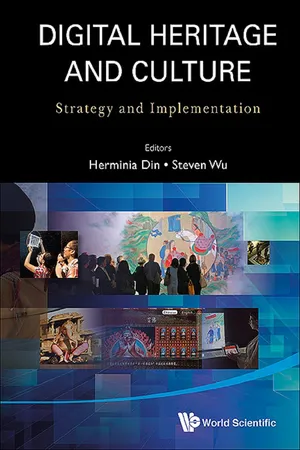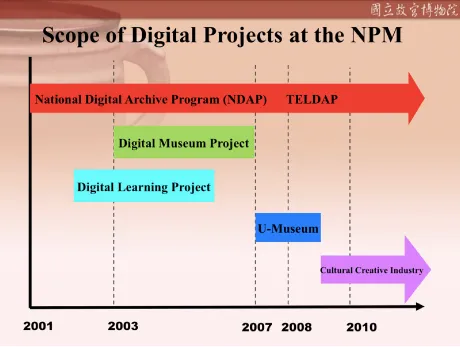![]()
PART 1
Strategy and Policy
![]()
1
IT-ENABLED INNOVATIVE SERVICES AS A MUSEUM STRATEGY: EXPERIENCE OF THE NATIONAL PALACE MUSEUM, TAIPEI, TAIWAN
James Quo-Ping Lin
Introduction to the National Palace Museum
The National Palace Museum (NPM) is a world-class institution with a collection of over 695,000 objects comprising renowned ceramics, calligraphy, painting, ritual bronzes, jade, lacquer wares, curio cabinets, enamel wares, writing accessories, carvings, tapestries and embroideries, and rare books and documents spanning over 8,000 years of Chinese history (List of Categories in the Collection, n.d.). The collection of cultural artifacts held inside the NPM consists of an enormous treasure trove of objects from the Song, Yuan, Ming and Qing Dynasties. Development of the NPM is closely connected to the social changes of modern China. In 1925, thirteen years after the founding of the Republic of China, the last Qing Emperor, Puyi, was exiled from the Forbidden City. The cultural artifacts left within the palaces were collectively itemized, and the NPM, a new museum atop the old palace, was born. However soon after its establishment, following the deteriorating situation of an impending Sino-Japan War, the NPM collections started their “drifting” years. Most of its holdings were moved into the inner land of mainland China to avoid damage from gunfire. In autumn 1948, fighting between the Nationalist and Communist armies took an adverse turn, and the Central Government made the decision to send its most precious objects in the collections to Taiwan. A total of 2,972 crates were shipped; while these accounted for only 22 percent of the items originally transported south from Beijing. In 1965, a new museum was built in the Taipei suburb of Waishuanxi. The new museum site was named the “Chung-Shan Museum” in honor of the founding father of the nation, Dr. Sun Yat-sen, and first opened to the public on the centenary of his birthday (Brief Chronology, n.d.).
Achievements of the IT-enabled Innovative Service in the NPM
As prize winners (Awards, n.d.) of several international museum competitions on digital products, the NPM in Taipei, Taiwan has much experience to share with museum colleagues world-wide in terms of strategy, possibilities, and challenges of introducing IT-enabled innovative services into a museum context in a broad sense. All these achievement will not be possible without support from a series of national IT-enabled innovative projects, as pictured in Figure 1. These projects started with the E-Taiwan Initiative introduced in 2000 with emphases on construction of information and communication infrastructure. In short, these include the Digital Archives, Digital Museum, E-learning, Ubiquitous Network Society (UNS), and Cultural Creativity projects. Hundreds of thousands of museum objects have been saved in digital forms, which have brought significant benefits to the museum and the society. In the aspect of museum operations, the digital images can enhance curatorial practices, conservation research, learning resources dissemination, cultural marketing, and so on.
In summary, the achievements of these projects include:
1. Extensive metadata systems for all collections;
2. Launch of websites in nine languages to provide wide knowledge of various subjects;
3. Installation of wireless network system;
4. Publication of e-newsletter with a circulation of 250,000 copies both in Chinese and English;
5. Providing e-learning and online exhibitions;
6. Application of various electronic media, including films of all types, mobile apps, interactive kiosks, and new media art into museum operation.
Figure 1. National projects of the NPM.
From the public standpoint, these achievements provide ubiquitous opportunities to learn the museum collections via a variety of approaches. It is expected that IT-enabled innovative services could bring more positive impacts to society, especially in terms of educational and economic benefits.
The Strategic Implication of Adopting IT-enabled Innovative Service at the NPM
The strategic implication of adopting IT-enabled innovative service at the NPM includes the rationale of adopting IT-enabled innovative service, structure and relationship among these projects, and the development stages of these projects.
The Rationale of Adopting IT-enabled Innovative Service
The reason why the NPM eagerly adopted IT-enabled innovative services can generally be divided into five aspects. The first was in response to the global trend in developing a knowledge-based economy and specifically the nurturing of digital-content industries. The second was in response to the trend in developing the digital museum. The third was the acceptance of central government policy directions. The fourth derived from the practical needs of the museum itself. And finally, the fifth was to face steepening competition the global museum industry. The rationale of adopting IT-enabled innovative services can be further elaborated as follows (Lin, 2007a).
First of all, in 1996, the Organization for Economic Co-operation and Development (OECD) issued the Knowledge-Based Economy Report, which became an important reference for countries around the world. The emergence of a knowledge-based economy has caused businesses to place greater focus on content and creativity, further highlighting the significant role of cultural content in economic development. Today, museums not only serve the long-established functions of storage, display, research, and education, but have also become an indispensable medium in the development of a knowledge-based economy, especially with respect to digital content industries.
Secondly, the Japanese scholar Sakamura (2000) discussed the evolution of physical museum to digital museum. He brings up several reasons museums in the 21st century use technology to integrate virtual and physical parts into digital museums:
1. Digital collections can provide more information than real collections.
2. By using hyperlinks, people can broaden their readings.
3. Faster communication speed.
4. Using 3D or planar technology to process relic information.
5. It can show the process of relic repairs.
In step with the development of computers and the Internet, museums are also moving toward the digital world. Digital museum can certainly spread the information all over the world — as, for example, online news would — in order to achieve the strategy of market expansion.
Thirdly, in accordance with the strategy of the central government in Taiwan, the Council for Cultural Affairs was responsible in the project Challenge 2008: Digital Taiwan for completing the digitization of all public museums’ collection in Taiwan by 2007. This, combined with the fact that Taiwan has already become the place in Asia with the highest broadband Internet penetration, shows that Taiwan already possess an environment of widespread information technology and communication, with Internet and telecommunication providers offering a plethora of services. Along with the robust development of the electronic information industry, Taiwan is truly taking off in the digital-content industry (Lin, 2007b).
Fourthly, we should also look at the actual need for digitizing the museum collections in order to further assist to serve the museum functions. As already mentioned, the four main functions of a museum are collection, exhibition, education, and research. However, they are often hindered by various factors, such as the inherent fragility of artifacts, limited exhibition space, set opening and closing times, the difficulty of database searching, and the inconvenience of using value-added applications. These obstacles also become impediments to the museum’s role as an educational institution. Only by removing these obstacles will the museum’s role as a provider of services, education, and cultural exchange be enhanced. In this regard, digitization offers a comprehensive solution to these problems. As far as the NPM is concerned, the digitization of cultural artifacts has been beneficial in the internal planning of exhibitions, management of the collection, training of staff, utilization of images and texts, and design of web pages. For the public, it has also been invaluable in providing educational services, supporting research, aiding the licensing and management of images, increasing value-added applications, encouraging innovative and content-based industrial developments, enhancing the upholding and protection of domestic culture, and inspiring the creation of digital information. Therefore, digitization of the collections in the NPM plays a significant role in the national development plan (Lin, 2007a).
Finally, through Michael Porter’s “Competitive Forces Model,” we can also observe the dramatic change in the overall competitive environment of the museum industry worldwide (Porter, 1980). Judging from the sheer number of competitors within this industry, the dramatically increasing number of museums around the world results in far greater direct competition compared to the past. Furthermore, on the customer level, various new trends — such as changes in consumer taste, reduction in the number of visitors, and the rise in popularity of traveling abroad — have created another crisis for the museum industry. From the viewpoint of suppliers and upstream industries, the awareness and study of art and culture requires a long period of investment to create something of limited quantity, therefore making it difficult for museums to display contents to satisfy the ever-changing needs of the marketplace. Furthermore, considering that the threshold for entering the museum field is not very high in Taiwan, the many newcomers have only intensified the already existing competition. Many substitute products and new services have become available, such as the rise of new leisure and entertainment means, including television, movies, arcades, and Internet games. This, when combined with other factors such as the recent economic downturn, political instability, stiffening of regulations, and the fast-paced and temperamental nature of the social and cultural environment, have all had a considerable effect on the museum industry. Faced with this difficult environment for management, most museums around the world have vigorously pursued any effective means of solving these problems. The digitization of museum collections is one of the most promising. Presently, many museums and institutions around the world are promoting the task of cultural digitization, some of the more prominent examples being the British Museum, the Louvre, the UN’s Memory of the World, the US’s American Memory, and Canada’s National Digital Collections (Lin, 2007a).
In summing up the above five issues — the new trend towards a knowledge-based economy, the trend in the development of the digital museum, accepting the direction of central government policy, the need for digitizing collections of artifacts, and acute changes in the overall competitive environment in the museum industry — the primary motivations behind the trend of developing digitization in museums around the world are clearly evident. In Taiwan, the task of museum digitization began in May of 1998 with the National Science Council of the Executive Yuan promoting the project “Towards the New Millennium — Humanistic Concern as the Focus of Technological Development for the New Century,” which included “Digital Museums” as one of its sub-projects. At the time, the NPM participated in this project under the theme of “The Beauty of Cultural Objects in the National Palace Museum.” Afterwards, through several changes and overhauls, the NPM proposed the three projects of “Production of a Digital Archives of Art at the National Palace Museum,” “Establishment of a Digital National Palace Museum and Value-added Applications,” and “National Palace Museum E-learning” as its plan to deal with the age of digitization.
Structure and Relationship Among These Projects
The strategies adopted by the NPM to the above ends will affect the distribution and utilization of its resources, and will also directly influence the achievement of its goals in digitization. When our digitization plan just started, a coherent plan was not yet in place for the long term outlook regarding such a plan for the NPM. It was undertaken mainly to cooperate with the government policies in which certain projects that fulfilled specific goals were developed. However, during yearly management meetings, we constantly reflected over each single step and eventually came up with a more developed outlook. Similarly, after much discussion and brainstorming, in the museum’s digitization plan, we concretely drew up a long term outlook for a digitization project and decided upon a yearly execution plan accordingly. This long term outlook is “based on the belief of combining culture and technology, set a model of the digitization for museums, create an example of digitalized collection industry, build a comprehensive economic system for museums” (Lin, 2007a).
Based on the long term outlook planned above, with regard to the execution strategy, due to the limit...


